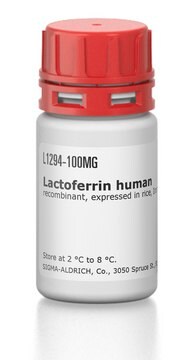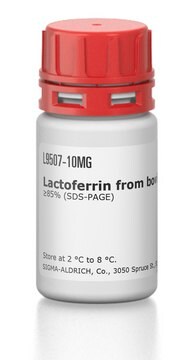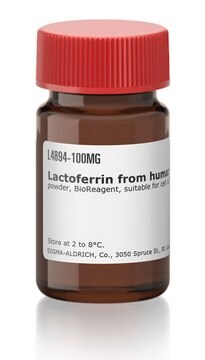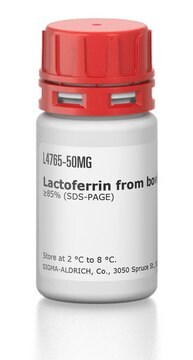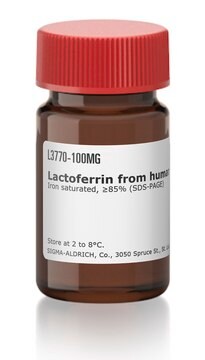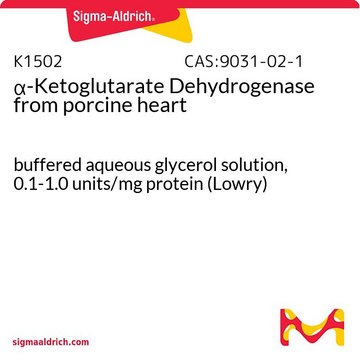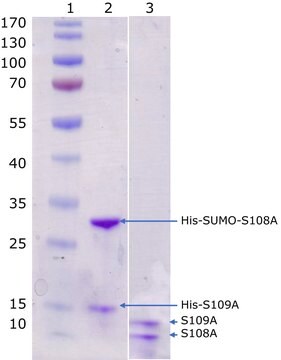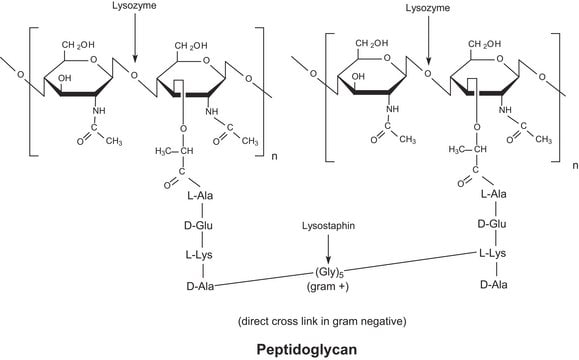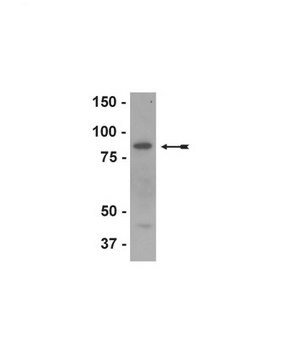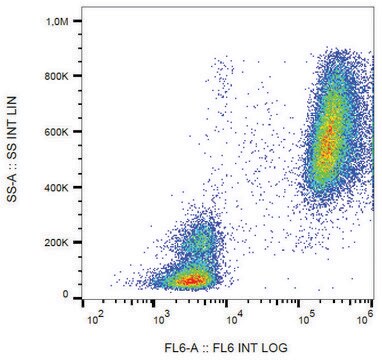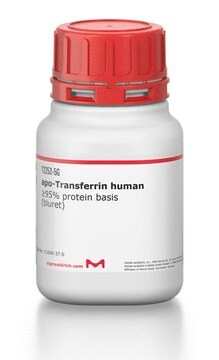L4040
Lactoferrin human
recombinant, expressed in rice, Partially iron saturated, ≥90% (SDS-PAGE)
Sinónimos:
Growth-inhibiting protein 12, Lactotransferrin, Talalactoferrin
Iniciar sesiónpara Ver la Fijación de precios por contrato y de la organización
About This Item
Productos recomendados
origen biológico
human
recombinante
expressed in rice
Ensayo
≥70% protein basis (Bradford)
≥90% (SDS-PAGE)
Formulario
powder
técnicas
microbiological culture: suitable
solubilidad
H2O: soluble 10 mg/mL
Nº de acceso UniProt
temp. de almacenamiento
2-8°C
Información sobre el gen
human ... LTF(4057)
¿Está buscando productos similares? Visita Guía de comparación de productos
Aplicación
Lactoferrin was used to grow Streptococcus mutans in an iron-limiting medium. It was used to test if lactoferrin impedes epithelial cell adhesion in vitro. It was also used to test the diagnostic value of blood cytokine concentrations in acute pneumonia.
Acciones bioquímicas o fisiológicas
Lactoferrin is an iron binding protein. It is structurally similar to transferrin, the plasma iron transport protein; but lactoferrin has a much higher affinity for iron (250 fold). It is very abundant in colostrum and small amounts can also be found in tears, saliva, mucous secretions and in the secondary granules of neutrophils. It is made by mucosal epithelium and neutrophils and is released by these cells in response to inflammatory stimuli. Bacterial growth is inhibited by its ability to sequester iron and also permeabilize bacterial cell walls by binding to lipopolysaccharides through its N-terminus. Lactoferrin can inhibit viral infection by binding tightly to the viral envelope protein. This prevents cell-virus fusion by blocking the binding domain. Lactoferrin appears to activate host defense systems in part by stimulating the release of interleukin-8, a neutrophil activator. It may also be involved in antibody and interleukin synthesis, lymphocyte proliferation and complement activation.
Código de clase de almacenamiento
11 - Combustible Solids
Clase de riesgo para el agua (WGK)
WGK 3
Punto de inflamabilidad (°F)
Not applicable
Punto de inflamabilidad (°C)
Not applicable
Equipo de protección personal
Eyeshields, Gloves, type N95 (US)
Elija entre una de las versiones más recientes:
¿Ya tiene este producto?
Encuentre la documentación para los productos que ha comprado recientemente en la Biblioteca de documentos.
Los clientes también vieron
Qingsheng Kong et al.
Molecular and cellular biochemistry, 406(1-2), 293-299 (2015-05-20)
The metalloprotease lethal factor (LF) from Bacillus anthracis plays a vital role in anthrax toxin action, and thus becomes a target for anti-anthrax therapy. Following the guidelines based on existing metalloprotease inhibitors, we designed a 'first-generation' LF inhibitor R9LF-1. This
P Kragsbjerg et al.
Thorax, 50(12), 1253-1257 (1995-12-01)
The role of cytokines in the pathogenesis of pneumonia is still poorly understood. In a previous study the diagnostic value of measuring blood concentrations of interleukin 6 and interferon gamma was established. In the present study the value of blood
Snehal Kadam et al.
Biofilm, 3, 100047-100047 (2021-04-30)
Bacterial biofilms are a major cause of delayed wound healing. Consequently, the study of wound biofilms, particularly in host-relevant conditions, has gained importance. Most in vitro studies employ refined laboratory media to study biofilms, representing conditions that are not relevant
Zhongnan Xiao et al.
Redox biology, 50, 102256-102256 (2022-02-09)
Diabetic hyperglycemia aggravates the prognosis of intracerebral hemorrhagic stroke (ICH) in the clinic. In addition to hematoma expansion and increased inflammation, how diabetic hyperglycemia affects the outcomes of ICH is still unclear. We found that streptozotocin-induced diabetic hyperglycemia not only
Growth of Streptococcus mutans in an iron-limiting medium.
Grace A. Spatafora, Meagan W. Moore
Methods in Cell Science : An Official Journal of the Society for In Vitro Biology, 20, 217-221 (1998)
Nuestro equipo de científicos tiene experiencia en todas las áreas de investigación: Ciencias de la vida, Ciencia de los materiales, Síntesis química, Cromatografía, Analítica y muchas otras.
Póngase en contacto con el Servicio técnico